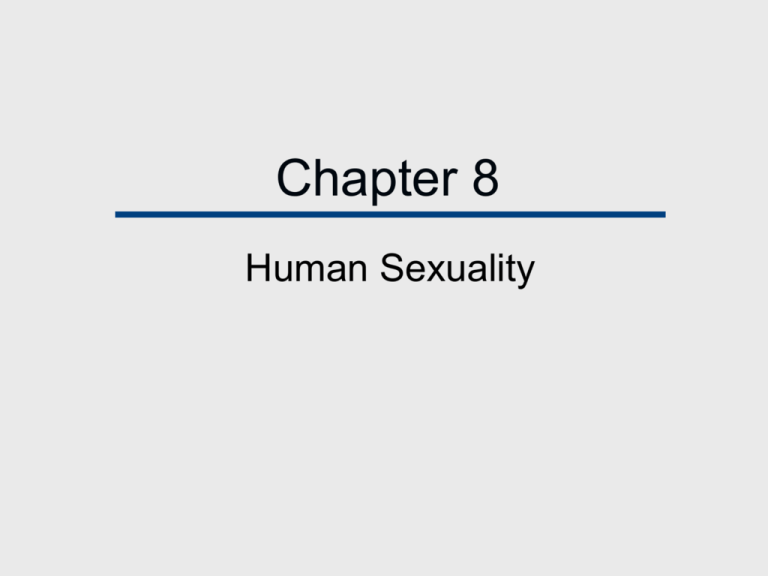
Chapter 8
Human Sexuality
Chapter Outline
• Human Sexuality in the United States
• Changing Sexual Mores
• Modifying Sexual Behavior
• Differences between Male and Female
Sexuality
Chapter Outline
• Physiology of the Sexual Response
• Marital Sex: Can I Keep the Excitement
Alive?
• Sex and the Aging Process
• Sex and Drugs
• Sexually Transmitted Diseases
Human Sexuality
•
Pervasive, involving humans
psychologically as well as physiologically.
•
Under conscious control, rather than
instinctual, biological control.
•
Affected by learning and social factors
and thus more variable within the species.
Human Sexuality
•
•
•
Largely directed by an individual’s beliefs,
values, and attitudes.
Less directly attached to reproduction.
Able to serve other purposes in addition
to reproduction, such as pair bonding and
communication.
Changing Sexual Mores
Double Standard no longer as strict.
Sexual Revolution made rules apply less.
Freer sexual expression for men and
women, heterosexual and homosexual.
Modifying Sexual Behavior
AIDS epidemic in 1980s
Boredom with recreational sex
Dating becomes focused on sex
Lack of intimacy and commitment
Differences between Men & Women
5 Leading Sexual Fantasies:
Heterosexual Men
1.
2.
3.
4.
5.
Replacement of established partner
Forced sexual encounter
Observation of sexual activity
Homosexual encounters
Group-sex experiences
5 Leading Sexual Fantasies:
Heterosexual Women
1.
2.
3.
4.
5.
Replacement of established partner
Forced sexual encounter
Observation of sexual activity
Idyllic encounters with unknown men
Lesbian encounters
Sexual Response Cycle
Excitement Phase
Plateau Phase
Orgasm
Prevalence of Female
Genital Mutilation
Physiological terms
•
•
Clitoris: A small organ situated at the
upper end of the female genitals that
becomes erect with sexual arousal;
homologous with the penis.
Orgasm: The climax of excitement in
sexual activity.
Sex and Aging
•
•
•
Menopause (climacteric): Cessation of
ovulation, menstruation, and fertility in the
woman, usually occurs between 46-51.
Estrogen Replacement Therapy (ERT): The
process of supplying estrogen to menopausal
woman.
Osteoporosis: Deterioration of bone strength,
possible symptom of menopause.
Sex and Drugs
Aphrodisiac: A chemical or other
substance used to induce erotic arousal
or to relieve impotence or infertility.
Anaphrodisiac: A drug or medicine that
reduces sexual desire.
Frequency of Orgasm (%)
Always
Usually Sometimes
Rarely
Never
Men
75
20
3
1
1
Women
29
42
21
4
4
Sexually Transmitted
Diseases (STDs)
Individuals under age 25 account for a
majority of cases.
Approximately 4 million teens get an STD
every year.
Experts estimate that as many as one in
three sexually active young people will
have an STD by age 24.
Factors in the Resurgence of
STDs
1.
2.
3.
The Pill
Antibiotics
The increased sexual activity among the
young, especially the increased number
of sexual partners.
Quick Quiz
1. A drug or medicine that reduces sexual
desire
a)
b)
c)
d)
Aphrodisiac
Anaphrodisiac
Estrogen Replacement Therapy (ERT)
Viagra
Answer: b
•
A drug or medicine that reduces sexual
desire is an anaphrodisiac.
2. According to the text, this is a symptom of
menopause
a)
b)
c)
d)
Cessation of ovulation
Cessation of menstruation
Osteoporosis
All of the above
Answer: d
•
Symptoms of menopause include
cessation of ovulation, cessation of
menstruation, and osteoporosis.
3. According to the text, individuals
under the age of 25 account for the
majority of cases of
a)
b)
c)
d)
Sexually Transmitted Diseases
Infertility
Unexpected Pregnancy
Inhibited Sexual Desire
Answer: a
•
According to the text, individuals under
the age of 25 account for the majority of
cases of sexually transmitted diseases.







